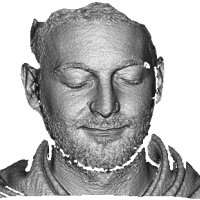New model for large-scale 3-D facial recognition

Researchers from The University of Western Australia have designed a new system capable of carrying out large-scale 3-D facial recognition that could transform the entire biometrics industry.
The model could be used by any organisation or government agency for more accurate 3-D facial recognition and could lead to widespread applications, and improving security measures while potentially removing the need for personal passwords.
Facial recognition is fast becoming the tool of choice for surveillance, security and IT industries and relies on the ability of computer models to determine whether or not a person is legitimate.
Currently, 2-D facial recognition of photographs is widely used and has seemingly surpassed human accuracy levels however it has several shortcomings that the more advanced 3-D model is able to address.
Unlike 2-D facial recognition software, 3-D models have the potential to address changes in facial texture, expression, poses and scale, yet the data is difficult to gather.
2-D facial data can be obtained simply by searching the internet while 3-D facial data requires physical collection from real subjects thereby limiting its use.
The research team from the UWA Department of Computer Science and Software Engineering created the first-of-its-kind model—called FR3DNet—analysing 3.1 million 3-D scans of more than 100,000 people.
They trained the model to learn the identities of a large dataset of 'known' persons and then match a test face to one of those identities.
The 3-D model's creator, Dr. Syed Zulqarnain Gilani, said the model was a huge step forward in the field of 3-D facial recognition.
"With off-the-shelf 3-D cameras becoming cheap and affordable, the future for pure 3-D face recognition does not seem far away," Dr. Gilani said.
"Our research shows that recognition performance on 3-D scans is better and more robust. Your 3-D scan could be in any pose, wearing glasses or a face mask, and laughing or just smiling and the deep model can recognise you in an instant.
"We hope that this research will help improve security on devices that use facial recognition to grant access to networks and systems."
The 3-D Facial Recognition model (FR3DNet) is currently available for research purposes. The paper was published in Computer Vision and Pattern Recognition.
Provided by University of Western Australia




















